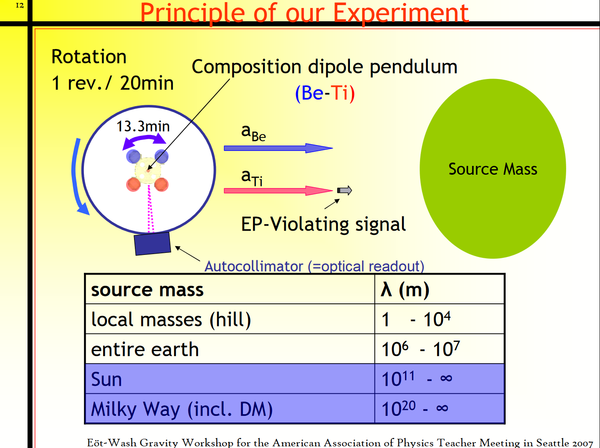Variations in Gravity
Short Range Variations in G
Medium Range Variations in G
Eöt-Wash Hill Experiments
From No Easy Answers: Science and the Pursuit of Knowledge by Allan Franklin, on p.70 we read a summary of the Eöt-Wash hillside experiments with the rotating torsion balance:
“ The Eöt-Wash experiment used a torsion pendulum located on the side of a hill on the University of Washington campus. If the hill attracted the copper and beryllium test bodies that were used in the apparatus differently, then the torsion balance would experience a net torque. None was observed. ”
An Eöt-Wash presentation explains (Archive) that the influence of an external source mass on these type of experiments would be a violation of the Equivalence Principle (EP).
Long Range Variations in G
Universality of Free Fall
The Newtonian gravitational constant: recent measurements and related studies
By George T Gillies
https://iopscience.iop.org/article/10.1088/0034-4885/60/2/001/pdf
p.200
5. Searches for variations in G
5.1. Spatial dependence of G
“ Searches for a change in G with intermass spacing have constituted a compelling quest in laboratory gravitation, especially during the past 25 years. The motivations for carrying out this kind of study were originally empirical, with the results of various benchtop experiments being interpreted in terms of either a value for or limit on some distance-dependent form of the gravitational constant (i.e. a G(r) effect), or in terms of a breakdown in the inverse square law (i.e. a modification to it of the form 1/r2+δ, where δ is the departure parameter). Then, in the 1980s, observations that seemingly revealed evidence for non-Newtonian gravity at larger distance scales (Stacey et al 1987) fuelled much additional interest in this line of work. The contemporaneous suggestion by Fischbach et al (1986) that there may be previously undiscovered, weak, long-range forces in nature provided further impetus for investigating the composition- and distance-dependence of gravity, since the presence of any such effect might reveal the existence of a new force. During this time, a theoretical framework for admitting non-Newtonian effects into discussions of the experimental results was emerging. It led to the practice of using the laboratory data to set limits on the size of the strength-range parameters in a Yukawa term added onto the Newtonian potential, and this has become a standard method for intercomparing the results of this class of experiments. Even though convincing evidence in favour of such new weak forces was never found, the many resulting experiments, when viewed as tests of the universality of free-fall, did much to improve the experimental underpinnings of the weak equivalence principle (WEP) of general relativity. In fact, searches for departures from the inverse square behaviour of Newtonian gravity have now come to be interpreted as attempts to uncover violations of the WEP. ”
p.202
“ Other recent experimental searches for a breakdown in Newtonian gravity at large distances include a second set of tower gravity measurements made by Romaides et al (1994). Their data, taken at five points over a nearly 500m vertical rise, reconfirmed the exactness of the inverse square law. A similar result over a vertical distance of approximately 320 m was obtained at a meteorological tower in China by Liu et al (1992). ”

